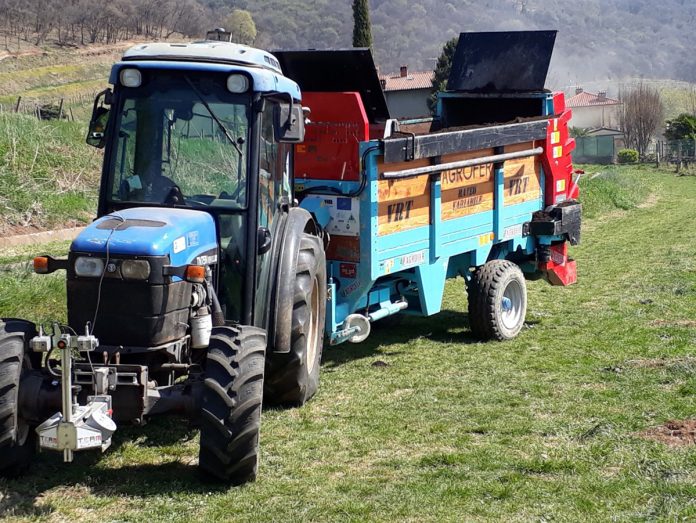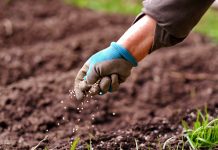Here, Paolo Mulotto discusses LIFE VITISOM, vineyard organic fertilisation management through a variable-rate distribution system
In the last few decades, consumption of soils due to agricultural activity has increased; one of the major problem, is the reduction of organic matter that in 2009 the European Community defined as a fundamental element for the soil fertility.
Positive effects of organic matter can be summarised in few points:
- It increases soil biodiversity;
- It is connected to soil fertility as organic carbon improve soil structure;
- It enhances the quantity of water retained by the soil.
Modern viticulture can represent a problem for the erosion of organic carbon as a higher density of plants and the increase of the use of mechanisation emphasise the loss of organic carbon.
Organic Fertilisation and Precision Farming
The use of organic fertilisation like manure, soil fraction of digestate and compost has different functions as for the soil as for the grapevine; it can modify and improve the chemical, physical and biological characteristics. The addition of this organic compounds should be carried out on the basis of some information as soil structure, presence of chemicals elements utilisable by the roots and biological activity.
It is a common practice to distribute the maximum doses necessary of fertiliser even if in the same vineyard the amount of manure, compost or solid fraction of digestate can spatially vary and lower doses can be enough.
Precision farming using hi-tech instruments to apply fertiliser only where it is needed is now a possible solution; this is what Variable Rate Technology (VRT) aims to achieve.
Aims of LIFE Vitisom Project
The LIFE15 ENV/IT/000392 – LIFE VITISOM project was funded by the LIFE program, the European Union’s funding scheme for the environment and climate actions. It sets out to promote sustainable vineyard management as part of the priority area of environment and resource efficiency, and in support of green and circular economy and soil health.
The main goals of the project are:
- To develop and to demonstrate an innovative technology to manage vineyard organic fertilisation: the project aims to implement the VRT (Variable-rate technology) to upgrade the vineyard organic fertilisation distribution systems, an innovation for the viticultural sector;
- To promote a more sustainable approach to vineyard soil management: this new technology leads to an improvement, at local and European level, of the quality of vineyard soils in terms of soil structure, organic matter content and biodiversity. This allows to prevent erosion, compaction and organic matter decline;
- To contribute to the definition of a complete framework for vineyard soil and organic matter management and to exchange of best practices in viticultural sector: the project allows to identify, through testings carried out in different pilot contexts, a complete framework of vineyard soil management, reproducible at EU level.
The development, testing and scale-up of a cost-effective technology for vineyard organic fertilisation was a key part of this endeavour. The University of Milan (UNIMI) was the coordinator for the project and was involved in the variable-rate technology (VRT) prototype design and validation (group of professor Pessina), as well as evaluation of soil chemical and biological conditions (group of professor Adani), vine, grape and wine characteristics (group of professor Valenti) and social and economic effects (group of professor Corsi).
The project included technical development of precision machinery in the form of VRT prototypes for different viticulture contexts that allow the application of organic fertiliser according to the needs of individual vines.
The prototypes developed by Casella Macchine Agricole in collaboration with UNIMI and TEAM group were tested to identify five different machines, each one suitable to be used in specific viticultural contexts. The final step is to develop prototypes for industry use. The various studies were conducted in three partner wineries (Castello Bonomi, Guido Berlucchi, Conti degli Azzoni) and in two testing sites (Bosco del Merlo, Cantina Castelvecchi) distributed in the north and in the center part of Italy. Other partners involved in the project were University of Padua (group of professor Pitacco) and West Systems (GHG monitoring) and Consorzio Italbiotech (communication and impact assessment).
The Variable-Rate Technology
The variable-rate technology is possible thanks to the use of the images that give information about the shape, the size and the volume of the plant; these imagines can be acquired during the vegetation period by satellite or airplane or drones with a remote-sensing approach or with a proximal-sensing approach by sensors that carry out continuous measurements near the plant. The last one is the case of the sensor used in the LIFE VITISOM project.
The images acquired from the sensor are used to divide the vineyard in different classes of vigor of the plants and for each class is associated a different amount of fertilisation; the class with a lower vigor is associated with a higher input of fertiliser, the class with a higher vigor is associated with a lower input of fertiliser. This is the approach used to try to homogenise the plants of a vineyard to have a more standardise quality in the grapes. An innovative sensor developed by TEAM group and Casella Macchina Agricole was used in the LIFE VITISOM project: this new system (MECS-WOOD sensor) is able to quantify vine vigor from woody unleafed branches making possible the variable rate distribution of organic fertilizers to be carried out in real time.
Principal results obtained with the project
The main results obtained after three years of research can be summarised in the following points:
Reduction of 38% of organic
fertilisers, 13% of odor impacts and 37% of greenhouse gases emissions;
Economic savings due to less use of fertilisers (up to 16%);
Reduction of vigor inhomogeneities (up to 38%) in the vineyards, increase of organic matter (+6,8%) and of the biodiversity in the soil.
Please note: This is a commercial profile











